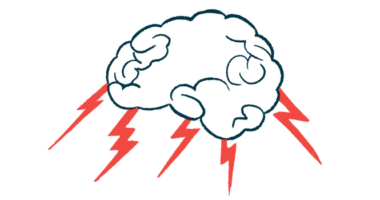Hand-held Device for Vagus Nerve Stimulation Eases Motor Symptoms in Trial

LRRK2 inhibitor
One month of non-invasive vagus nerve stimulation (nVNS), administered at home using a hand-held device by electroCore, improved walking and motor abilities, and eased freezing of gait in adults with Parkinson’s disease, according to data from a small clinical trial.
Freezing of gait refers to a patient’s feeling for an extended period as if their feet are “glued” to the floor, and they are unable to move forward.
Notably, these motor benefits were accompanied by a reduction in pro-inflammatory molecules and a rise in antioxidant and nerve cell survival molecules, suggesting the therapy has potential anti-inflammatory, antioxidant, and neuroprotective effects.
Larger trials are needed to confirm these early findings in this patient population, the researchers noted.
“We are pleased to have successfully completed the first randomized, double-blind sham-controlled trial to demonstrate the efficacy of cervical nVNS as an adjunctive therapy in PD [Parkinson’s disease],” Hrishikesh Kumar, MD, the study’s senior author and the director of research and vice chairman of the Institute of Neurosciences Kolkata, in India, said in a press release.
“Improvements in motor function and gait after one month of treatment with nVNS were significant,” Kumar said, and trial results “clearly support additional work to further understand the potential for nVNS in this indication.”
The study, “Non-Invasive Vagus Nerve Stimulation Improves Clinical and Molecular Biomarkers of Parkinson’s Disease in Patients with Freezing of Gait,” was published in the journal NPJ Parkinson’s Disease.
Vagus nerve stimulation consists of delivering gentle electric pulses to the vagus nerve, an important highway of communication between the brain and the body, and one that passes through the neck and thorax in reaching the abdomen.
This type of treatment approach, delivered through a surgically implanted device, has been an approved add-on therapy for epilepsy for more than 20 years, and shown to also be effective in treating depression and headaches.
More recently, hand-held and non-invasive VNS devices that don’t require surgical implantation have been approved to treat various conditions, such as epilepsy, depression, pain, and several types of headaches.
ElectroCore’s nVNS device, called gammaCore Sapphire, is approved in the U.S. and Europe for the treatment of migraines and headaches. Designed as a portable and easy-to-use technology, gammaCore can be self-administered by patients by placing the device over the vagus nerve in their neck.
Previous, early studies in a rat model of Parkinson’s and in patients pointed to VNS/nVNS as a potentially effective approach for treating walking difficulties associated with this disease.
Increasing evidence also suggests that VNS can reduce pro-inflammatory molecules and oxidative stress, both involved in Parkinson’s. (Oxidative stress is an imbalance between the cell’s production of harmful free radicals and antioxidant molecules to detoxify them.)
However, the effects of sustained nVNS treatment in Parkinson’s patients remain unclear.
Researchers at the Institute of Neurosciences Kolkata, in collaboration with the Faculty of Medical Sciences at Newcastle University in England, conducted the first appropriately controlled trial to evaluate the safety, feasibility, and effectiveness of nVNS in treating walking difficulties and other motor symptoms in Parkinson’s patients.
Their study included 33 patients (ages 30–80) with freezing of gait, who were enrolled at a hospital in eastern India.
Fourteen patients were randomly assigned to one month of two, two-minute nVNS sessions, applied three times a day (for a total of 12 minutes per day) at their home using gammaCore Sapphire, while 19 others did the same with a similar but sham device.
After a washout period of one month, participants were assigned to the alternate intervention, again for one month. A total of 21 patients completed the study, and as such, were given both nVNS and the sham procedure.
All patients were assessed for Parkinson’s-related motor and non-motor symptoms through validated clinical measures. Blood levels of BDNF — a nerve cell survival-promoting protein that is at low levels in Parkinson’s patients — and markers of inflammation and oxidative stress were measured in a subgroup of patients.
Results showed that one month of nVNS significantly improved overall motor function and key walking parameters, including walking speed, stance time, and step length, compared with the sham procedure.
Particularly, nVNS was associated with patients “walking not only with a faster pace but also with improved rhythm,” the researchers wrote.
No significant differences were observed between treatment and sham in terms of patient falls, freezing of gait, cognitive function, and sleep. Notably, while the mean duration of freezing episodes during walking assessments significantly decreased only in the nVNS group, patients’ perception of frozen gait was similar between gammaCore Sapphire and sham device use.
Treatment with nVNS also significantly reduced the levels of the pro-inflammatory TNF-alpha protein, and increased those of BDNF and of a powerful antioxidant molecule called glutathione.
These findings provide “the first evidence that nVNS downregulates major pro-inflammatory [molecules], upregulates BDNF and increases levels of the antioxidant (reduced glutathione) in PD patients, and that nVNS might have disease-modifying effects in PD,” the researchers wrote.
They also noted that these molecules, along with motor improvements, may serve as biomarkers of responses to nVNS in future studies.
Patients were generally satisfied with the treatment, and all but two were able to self-administer it. Adverse events were infrequent, non-serious, and similar across both intervention groups.
“The study provides preliminary evidence supporting the safety and efficacy of nVNS in treating motor and non-motor symptoms of PD,” the team wrote, adding that larger, multi-center trials are needed not only to confirm these findings but also to optimize treatment parameters.
Eric Liebler, senior vice president of electroCore’s neurology, said the company “is looking forward to continuing research to bring nVNS to patients with PD.”






